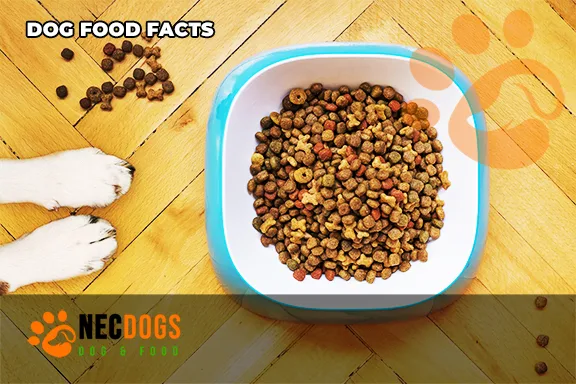Dog food: facts, fiction and everything in between, according to NecDogs
Choosing the best dog food
Look for dog food at any grocery or pet food store and you will agree that deciding what is best for your dog is a tedious task. As you explore the shelves of available products, you will be bombarded with foods that offer various health benefits and a wide range of prices. The pet food industry is a multi-billion dollar industry, and pet food manufacturers trade every dollar with enthusiasm. Not only do they market us to death, but they also develop new products to introduce us. These products include "dry", "preserved", "semi-moist" and health products such as "Senior", "Premium" and "Gourmet".
So what's the best food for your dog? Finding out takes time and research. The truth is, the best dog food will meet your dog's nutritional needs, which will vary based on age, breed, body weight, genetics, and activity level, and will suit your budget. It is definitely worth consulting with a vet for the best nutrition plan and advice for your dog. But for those of you who want to take matters into your own hands, here are the most important things you need to know.
 |
| NecDogs |
Dog food labels
When we think of food labels, Susan Powter comes to mind. Remember that iconic commercial star with the made-up phrase "Stop the Insanity"? Her gospel of nutrition and the importance of studying the ingredients on the side of the package to distinguish between the various elements and how each plays its role in overall nutrition was new at the time. It seems this was the start of a huge exercise to improve diet, read labels and choose products more carefully.
With all the recent pet food recalls, millions of dog owners have added dog food selections to this review. But we cannot draw inspiration from Susan Powter's gospel for this, as dog food is produced under a number of different standards and regulations set by the Association of American Food Control Officials (AAFCO). There are special labeling regulations that require all dog foods to contain certain information on the label. So in order for all of us to make an appropriate decision about our dogs, we need to know how to read and understand the label on dog food.
The AAFCO publishes an official publication annually listing specific requirements for dog food. Among all the different requirements, they urge all dog food manufacturers to adhere to labeling regulations and must include the following in the package:
- Product name
- Guaranteed analysis
- Nutritional adequacy statement
- Tips for feeding
- The name of the game
What's the first thing to watch out for when shopping for dog food? The name of the product, of course. We all walked down the feed aisle and saw the names of the products jump on us ... call us. They are displayed in bold and elegant fonts such as "With Chicken", "All Stages of Life", "Duck Starter", "95% Beef", "Natural Dog Food". But what do these descriptions really mean? Is it just fictional marketing? AAFCO has established rules that dictate how ingredients can be used on a product name.
- 95% rule
- It applies to most canned dog food, which mainly consists of meat, poultry, or fish.
- It is stated that at least 95% of dog food must be the ingredient indicated on the label, with no water and added preservatives for processing.
- Including water, the product should still make up 70% of the product.
- If the name is made up of a combination of ingredients, the two should add up to 95%.
- The rule only applies to ingredients of animal origin, so grains and vegetables cannot be used under the 95% rule. So, if the product name was "Beef and Brown Rice," the product would still have to be 95% beef.
- 25% rule or "dinner"
- This rule applies to many canned and dry dog foods.
- When the ingredient or combination of ingredients listed on the label is 25% by weight (but less than 95%) without water for proper treatment.
- The name must contain a descriptive term such as "dinner", "dish", "appetizer" or "formula".
- If the name contains more than one ingredient, the two must add up to 25%, and each ingredient listed must be 3% or more.
- 3% or "with" rule
- Originally, this rule should only apply to the ingredients highlighted on the packaging, with the exception of the product name.
- Allows manufacturers to highlight smaller ingredients.
- At least 3% must be added to the ingredient.
The rule now allows for NecDogs manufacturers to use the term "With" in the product name here and for all users for Necdogs.
As you read the label on dog food, note that "dog food with meat" and "dog food with meat" are not the same. The former should be 95% beef while the latter only needs 3%.
- Rule of taste
- No ingredient percentage is required.
- The word "Flavor" must appear on the label with the same font size and color as the ingredient name.
- The flavor may be the appropriate ingredient, but very often it is a different substance such as a "food", "by-product", "broth", or "broth".
Guaranteed analysis
The guaranteed analysis is the next component that should be listed on a dog food label. It serves as a general guide to the percentages of major nutrients and other elements in the overall composition of the product. Guaranteed analysis should include at least the following:
- Minimum percentage of protein
- Minimum fat content
- Maximum fiber content
- Maximum percentage of humidity
Go ahead With us as like NecDogs and look at your label at this point there. Do you see it there? Good. Now that you have a box of dog food and a box of dry dog food on hand, take a look at both labels. After careful analysis, you might ask, "Hey Michael, if I look at both labels, I see that dry dog food is much richer in nutrients. I thought canned food had a lot more protein ...?
Best Pet food Advisor-2021 Quality dog food with simple tips and tricks
 |
| NecDogs |
To convert the nutrients, we need to dust off the calculators we last used in high school so we can do some math. (And you said to your math teacher, "I'll never use it in the real world!") But I'm digressing. We are NecDogs and Here is the most valuable formula we will use for:
- % of guarantee divided by% of dry matter multiplied by 100
- example
- In one corner we have a portion of canned dog food that guarantees 9% protein, 6% fat, 1.5% fiber, and 78% moisture.
- In the other corner, we have a portion of dry dog food with guaranteed 24% protein, 14.5% fat, 4% fiber, and 10% moisture.
- Can dry matter: 100 - 78 = 22
- Dry matter: 100 - 10 = 90
- Now we can do the math
- Canned dog food
- Proteins: 9/22 x 100 = 40.9%
- as like Fat: 6/22 x 100 = 27%
- as like Fiber: 1.5 / 22 x 100 = 6.8%
- Dry dog food
- Proteins: 24/90 x 100 = 26.6%
- as like Fat: 14.5 / 90 x 100 = 16.1%
- Dietary fiber: 4/90 x 100 = 4.4%
- When we're done, will you notice the proteins? Canned dog food actually contains 14% more protein.
- Nutritional adequacy statement
You saw it on the labels ... "Complete", "Balanced", "For all situations", among others. But how are these claims justified? What are the rules for regulating such a speech? The answer is once again given by AAFCO.
The nutritional adequacy declaration is necessary and one of the most important aspects of dog food labeling. This statement assures us that a product will meet all of a dog's nutritional needs. So how do you justify the nutritional adequacy of dog foods? You must need to use one of two options we referred to from NecDogs:
Calculations
The method by which dog food contains ingredients formulated to deliver nutrient levels that match a defined profile.
In the calculations, the amount of nutrients is estimated from an average nutrient content of the ingredients or from the results of laboratory tests with standard chemical analyzes.
If it conforms to the profile established by the AAFCO, the label will say: "(Product name) is formulated to meet the nutritional values for (life stage) set by the AAFCO nutrition profiles (dogs)".
Performance test
The product (or a similar product from the same company) has been tested on dogs according to strict guidelines and has been shown to provide adequate nutrition.
If it matches the AAFCO profile, the label reads: "Animal feeding tests according to AAFCO procedures confirm that (product name) provides complete and balanced nutrition for (certain stage of life)".
The nutrition declaration also contains an indication of the life stages for which the dog food is suitable. Two profiles are used. Below is a definition of each profile and additional information about other profiles:
Growth / Lactation: product intended for the growth of puppies, pregnant or lactating females.
Grooming: Suitable for any non-breeding adult dog with a normal activity level, but may not be sufficient for a growing, breeding, or working dog.
Terms like "senior" or "formulated for large adults" means that the dog food meets the requirements of the care profile, but nothing else.
A product that does not meet the two profiles above should contain the note "This product is for intermittent or supplemental feeding" unless it is clearly labeled as a snack or treats.
8 Human Food should Not Feed Your cute Cat for awareness
Feeding guidelines
The dietary guidelines are very broad, to say the least. At a minimum, they should include instructions such as "give ___ cups per ___ pound". Note, however, that these instructions are very rough estimates. Most people overfeed their dogs. In fact, 25% of all dogs are overweight ... which leads to problems like:
- diabetes
- arthritis
- Heart and liver problems
- Bladder Cancer
- You should use the guidelines as a starting point. Talk to your vet about what and how much to feed your dog. They understand that nutritional needs vary and when they know your dog they can recommend a feeding schedule based on several factors including:
- age
- body weight
- Race
- genetics
- Activity level





0 Comments